- Home
- Douglas E. Richards
Infinity Born Page 2
Infinity Born Read online
Page 2
For years the concept of an electromagnetic drive that would revolutionize space travel had captured the imaginations of crackpots. Even a few legitimate scientists—including a NASA group tasked with exploring exotic concepts for future propulsion—had detected slight amounts of propulsion being generated by such a device, dubbed the EmDrive. Still, the majority of those in the physics community were convinced this was nothing more than experimental error and that anyone who believed otherwise was a self-delusional idiot.
There was good reason for this dismissal. The EmDrive flew in the face of accepted physics—the only flying most believed it would ever do. Since the days of Newton, it was clear that for every action you needed an equal and opposite reaction. You could move an electric car on Earth without the need for propellant, true, but only because the car had the road to push back against, providing forward movement.
But in space, with nothing to push against, if you wanted to drive a rocket or a spacecraft forward, you had to shoot something out of its back end. Nothing in space could be propelled without propellant. Period. End of story.
Only those behind the EmDrive claimed the device could achieve propulsion in a vacuum without expelling anything, without the need for heavy fuel that weighed down spacecraft and made travel to Mars and beyond prohibitively costly and time consuming. The drive was a truncated cone, narrower at one end than the other, and totally enclosed. It created force by bouncing electromagnetic radiation back and forth inside of it—in this case, microwaves.
Believing this strategy could work was as ridiculous as believing you could get your car to move forward by sitting inside of it and bouncing ping pong balls against the dash. It was utterly absurd.
But the data stubbornly continued to show that this is exactly what was happening. That this reactionless drive had somehow found a loophole in the laws of nature.
Isaac Jordan, high school dropout, decided to take the data at face value and see where this would lead him. Einstein had done the exact same thing a century earlier. At that time, data seemed to indicate that the speed of light was exactly the same no matter how fast its source was moving toward or away from an observer. Instead of decrying this result as impossible, Einstein decided to determine what the laws of physics would have to be for it to be true. What he found—that as objects approach light speed their time slows relative to unmoving objects, their mass increases, and their length decreases—at first ridiculed by many, was later proved to be true in every instance, and had totally upended physics.
At the age of twenty-six, Isaac Jordan managed to do nothing less. By assuming the EmDrive effect was real rather than a hoax, he was able to completely rewrite the laws of physics. His work was utterly revolutionary. Disruptive. Profound.
Jordan should have been a lock to receive a Nobel Prize, but the fact that he didn’t even have a high-school diploma weighed against him. Einstein had been a lowly patent clerk when he had done his seminal work, but he, at least, had earned a PhD, and his Nobel Prize wasn’t awarded until fifteen years after he had developed his theory of relativity, and not even for this contribution.
But even so, even without a formal education, Jordan’s contributions were so unparalleled the Nobel committee couldn’t possibly deny him his due. Couldn’t, at least, unless he committed an unpardonable sin, which he managed to do with breathtaking speed.
Instead of going forward as an academic purist to develop his theories further—the kind of academic purist the committee liked to reward—he had shown himself to be a ruthless capitalist. He had wasted no time in patenting numerous applications for his theoretical discovery, leaving the ivory tower realm of science to exploit them commercially, forming yet another company, Space Treasure Industries, or STI.
His theories allowed him to perfect a Reactionless-Drive design that put the fledgling EmDrive to shame. He rapidly built a fleet of relatively inexpensive R-Drive-powered spacecraft that could reach Mars in weeks, rather than months or years, and which he initially used to mine the Moon and asteroids, beating several long-running companies to the punch.
The Moon possessed bountiful quantities of helium-3, extremely rare on Earth. Helium-3 was the perfect fuel source for nuclear fusion, a fuel the Sun produced in great quantity and dumped on the Moon, but which Earth’s magnetic field rejected.
But as lucrative as Jordan’s helium-3 mines quickly became, the asteroids were his figurative—and literal—gold mines. They contained treasures galore, a ridiculous bounty of gold, silver, osmium, iridium, palladium, and platinum, along with numerous other rare and expensive materials.
Within eight years of turning the physics world upside down, Isaac Jordan did the same with the world’s economy, flooding the markets with precious metals and making himself the first ever trillionaire in the process.
With this vast wealth he went on to establish a thriving colony on Mars, this time beating Elon Musk to the punch, selling the reality TV rights to life in the colony for almost as much as the project had cost him.
He was known to be brilliant, relentless, and ruthless—at least when he felt he had to be. He was an absolutely unstoppable force. Anything or anyone standing between him and one of his goals didn’t stand a chance.
His mind, his wealth, his ambition, and his plans for the future were so much larger than life they had become almost absurd.
And of the multitude of entries he could have added to his résumé, mass murderer was the last one anyone could possibly have foreseen.
3
Dillon Mattison’s full attention returned once more to a bunker deep under the West Wing of the White House. He stared deeply into the eyes of his Secretary of Homeland Security and saw absolute conviction there. Isaac Jordan’s guilt remained to be seen, but Jeff Brown was certainly convinced of it.
“My experts were able to backtrack the kinetic round’s path,” began Brown, “and crosscheck it with every satellite and spacecraft in orbit. There was no doubt where the round originated. Like I said, from the Eureka, the flagship of Jordan’s R-Drive fleet.”
“Too easy,” said Chris Best. “A guy this smart would have covered his tracks so he could never be connected to this atrocity. It has to be someone in Jordan’s employ. Or a frame-up. Just because a murder takes place in a building Isaac Jordan owns doesn’t make him a murderer.”
“My team and I thought the same thing,” said Brown. “What motive could he possibly have? A man wealthier and more famous than God? We looked into it, and several of the corporate headquarters that were destroyed did compete with some of the businesses he’s now in. Still, the motive had to be a lot more visceral than that to trigger this kind of response. Besides, when you almost literally own the world, who isn’t a competitor?”
Brown shook his head, as if still unable to believe his own findings. “So we did a lot of exploration, a lot of waking people up. I can go into detail later, but the picture that emerged left little doubt that he was personally responsible. He personally ordered the tungsten round built to the exact specifications of the one that hit New Silicon Valley. To the centimeter. A telephone-pole-sized tapered rod. He lied about its purpose to those who built it for him. He said he was looking into new techniques for skyscraper construction and wanted to use it in several experiments. The people who built it for him had no reason to doubt him, or suspect what it was really for.”
He sighed. “The good news is that he only had one. The manager in charge of the project was certain, because he offered Jordan a deep discount if he would buy in greater quantity. But Jordan insisted that only a single unit be produced, and that the mold be destroyed right afterward.”
“This manager could have been dealing with an impostor for all we know,” said Nevins.
Brown shook his head. “We verified this intel in several ways,” he said. “We have no doubt that the man who ordered the kinetic round was Isaac Jordan, that only one was made, and that only one was loaded onto any of his spacecraft.”
Mattison was still far fro
m convinced of Jordan’s guilt, and he could tell by the body language of those around the room that he had plenty of company.
“But this is only the beginning of what we found,” continued Brown. “We also discovered Jordan created a complex computer system for the sole purpose of taking control of the Eureka and the tungsten payload in its cargo hold. Remotely. With the necessary precision to hit any target he chose. The control system was installed in the only building he owns in the city of Turlock. A manufacturing plant three miles beyond the ring of death.”
The president considered. Whoever framed this man had done a skillful job. Mattison had little doubt the rod had been loaded onto the Eureka and dropped from this ship as Brown had determined. Placing a computer that could access the ship and its payload in the only building Jordan owned in Turlock, which happened to be located just beyond the devastation, had been a masterful touch. “What does he manufacture at this plant?” he asked.
“An advanced form of graphene,” replied Brown. “For those not familiar, I’m told graphene is a carbon structure that forms two-dimensional honeycombed sheets. You can make it a superconductor, and it’s two hundred times stronger than steel. Apparently, Jordan uses the stuff in his ships, but there is no obvious connection between graphene and this attack, other than the facility’s proximity to ground zero.”
“The evidence so far is all circumstantial,” noted Vice President Blask.
“It won’t be by the time I’m finished,” replied Brown. “To continue, we also learned that the computer Jordan set up to control the Eureka could only be accessed by him,” he added. “It had multiple levels of security. Access not only required complex passwords that only Jordan knew, but also his presence. His willing presence. He installed a sensor on the computer capable of measuring his unique brain activity signature, which could only be read if he were still alive. No match, no entrance. Finally, before the system would let him in, he had to pass the equivalent of a sensitive lie detector test. Unless he truthfully indicated he was accessing the computer of his own free will, he would be shut out.”
The more certain the evidence against Isaac Jordan seemed, the more convinced Mattison became that the tech icon could not be behind it. He was far too smart, and the case against him far too tight.
“Someone must have found a way past these safeguards,” insisted the president. “What’s more likely, that someone found a way to hack this unhackable system? Or that Isaac Jordan willingly killed thousands of people?”
“I put dozens of my best agents on this,” said Brown, “and we all shared your skepticism. Even after uncovering incontrovertible evidence that Isaac Jordan built and installed the kinetic rod on the Eureka and was the only one with the keys. So we continued to turn over every stone we could find. Turns out that Jordan has actually been living in Turlock for the past twenty months, not his corporate headquarters in Seattle. Living about four miles beyond the zone of death, in fact, and a mile from his graphene facility.”
“This makes sense,” said Lou Nevins. “If you want to frame Isaac Jordan, you have to be sure any smoking gun you plant is within his easy reach.”
Brown winced. “Speaking of smoking guns,” he said, a look of revulsion momentarily appearing on his face, “we discovered video footage taken by security cameras in his home. The footage was taken using a quantum verification system, so it couldn’t have been doctored without us knowing it.”
He blew out a long breath. “I’ll run it on the main screen now,” he said grimly. “But I have to warn you—it isn’t for the faint of heart.”
Mattison’s eyes narrowed. After the horrors they had seen over the past three hours it was hard to imagine anything could throw them at this point. The fact that Brown thought this footage might do the trick was troubling.
The video opened with a man who was unmistakably Isaac Jordan entering his mansion home. The vast structure was well lighted on the outside and absolutely magnificent, although understated compared to many of his other residences around the world.
“This is just over twenty minutes before the rod hit,” explained Brown. “We learned from the computer on the Eureka that two hours earlier, Jordan had already set the strike in motion.”
“On some kind of time-delayed fuse?” said the president.
“Exactly.”
“Not to be a broken record,” said Nevins, gesturing to the man on the screen who was now inside of the home, “but, again, can we be sure this isn’t an impostor?”
“Yes,” said Brown. “The richest man in the world has the best security system money can buy. It wouldn’t let him enter if it didn’t confirm his identity biometrically in several different ways.”
The group watched, spellbound, as Jordan walked straight to his private workshop, which was the size of a ballroom and filled with enough advanced tools and machinery to make the fictional Tony Stark envious. Dim lights came on in front of him as he walked and then were extinguished as he passed. Jordan was legendary for his tireless work ethic, and the lights had clearly been programmed to light his way when he came home after dark while causing minimal disturbance to the rest of his family.
He moved purposefully to a large steel cabinet and removed a Sig Sauer X490 Futura handgun from a drawer, one of a small collection of weapons developed during the early 2020’s with advanced muffling and noise-canceling technology that made the gun whisper-quiet.
No one in the Deep Underground Command Center spoke, but this was an intriguing development. Had this scene simply been the opening of a movie they would have been hooked, needing to know what happened next. But given this footage was reality, and touted as the ultimate evidence against the richest man on Earth for the murder of thousands, it could not have been more riveting.
Jordan walked briskly to the master bedroom where his stunning wife was sleeping soundly, just visible in the dim lighting that continued to follow him around. He pointed the Sig Sauer at her lithe body and held it steady for almost a full minute. Then, without warning, the gun spat three times in quick succession, and his wife’s sleep became permanent, her life ended before she had any idea she was even in peril. Bright red blood gushed from her torso onto the thin satin sheets.
When the life-sized man on the monitor had pulled the trigger, most of those deep under the White House had jumped, mirroring the brief, spasmodic movements made by Jordan’s wife as the bullets punched holes through her body. Gasps of surprise and horror could be heard throughout the conference room.
On the screen, Jordan was now surveying his handiwork. A broad grin spread over his face as he tilted his head to watch the blood accumulate. He bent over, turned his wife’s head so it was facing him, and pushed open her eyelids. Finally, Isaac Jordan stared into the lifeless eyes of a woman whose beauty was flawless, even in death, with utter malevolence. “Good riddance, bitch!” he spat, and then quickly exited the room.
This scene was repeated twice more, as Jordan made his way into each of his two sons’ bedrooms, ages ten and twelve, his expression more and more maniacal, and ended their lives while they slept, the gun as quiet as advertised.
A stunned silence came over the Command Center conference room, and all eyes remained glued to the scene that continued to unfold on the large monitor.
Jordan had now made his way to the home’s entry foyer and began running full speed into the oversized oak door, crashing his body against it with bone-jarring force, as if he were a charging bull and the door a red cape.
What the hell? thought Mattison in dismay. He had heard once that there was a fine line between genius and insanity, and it was clear that this line had snapped completely in Isaac Jordan’s case. But slamming into a door seemed even more random than wiping out his family.
On the screen, Jordan had done considerable damage to his body, and he was now certainly bruised and in great pain, but he didn’t appear to have broken any bones. He repeated his charge four times, dazed after each attempt. Finally, the fifth time, he tilted hi
s head forward at the last instant, something he had managed to avoid until then, so that it took the brunt of the impact.
He collapsed to the floor like a sack of cement and remained there.
Brown paused the video. “To save time,” he said, breaking viewers from their trance, “we’ll skip ahead. Jordan doesn’t move for a while. He’s still out cold when his kinetic round hits, thirteen minutes later. The shock wave passes through his house, shaking it like an earthquake would, but he’s already on the floor and doesn’t take any further damage. He finally returns to consciousness three minutes after the strike. We’ll pick it up there.”
When the footage resumed, Isaac Jordan looked dazed, as expected, and far worse for wear, as though he had just returned from a particularly nasty bar fight. The malevolent smile he had displayed while killing his family was gone, as was the maniacal gleam that had been in his eye while repeatedly ramming a door.
Instead, unexpectedly—as if anything else they had witnessed could have possibly been expected—his face twisted up in a rictus of pain and tears began to flow down his cheeks. This didn’t change for almost half a minute, until he suddenly shook his head, as if to clear it. A look of resolve and determination now came over his face and his tears began to slow.
While nothing Isaac Jordan had done made any sense, it had become abundantly clear that it didn’t need to. He was a raving psychotic. He didn’t need a rational motive for dropping his kinetic weapon on Turlock, California, because he was demonstrably irrational. Crazed might be a better word.
He walked briskly back to the workshop in which he had stored his gun, but this time he retrieved an axe. He quickly carried it back to the scenes of his crimes, to each of three bedrooms, and then, one by one, hacked off the heads of his wife and sons like they were cords of wood he was preparing for his fireplace.
Tears returned to his face as he carried out these grisly beheadings. In each instance it took him several swings of the axe to cleave cleanly through a neck, and in each case the blood poured rather than spurted, as each heart had stopped pumping the red substance twenty minutes or so earlier.

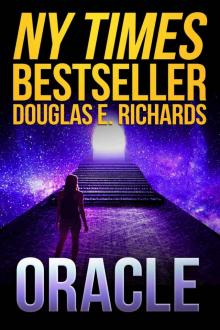 Oracle
Oracle![[2016] Infinity Born Read online](http://i1.bookreadfree.com/i/03/18/2016_infinity_born_preview.jpg) [2016] Infinity Born
[2016] Infinity Born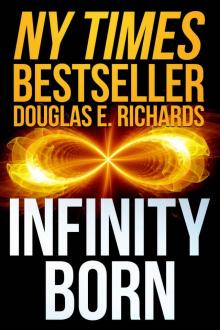 Infinity Born
Infinity Born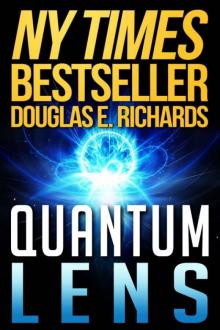 Quantum Lens
Quantum Lens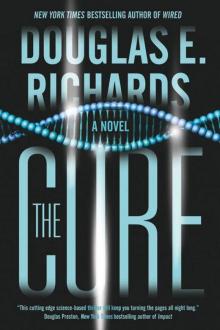 The Cure
The Cure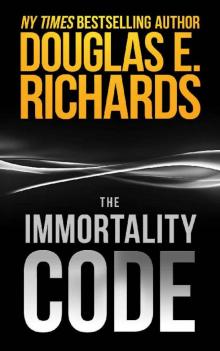 The Immortality Code
The Immortality Code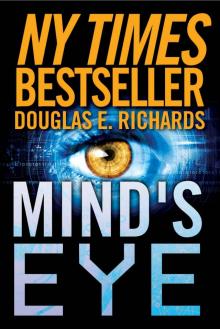 Mind's Eye
Mind's Eye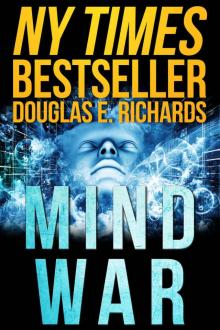 MindWar (Nick Hall Book 3)
MindWar (Nick Hall Book 3)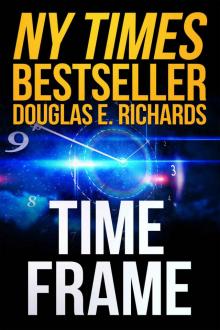 Time Frame (Split Second Book 2)
Time Frame (Split Second Book 2)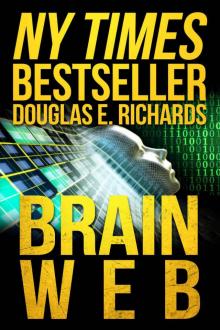 BrainWeb
BrainWeb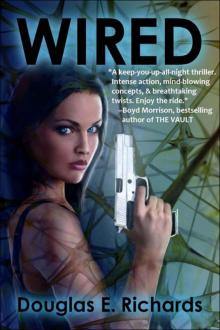 Wired
Wired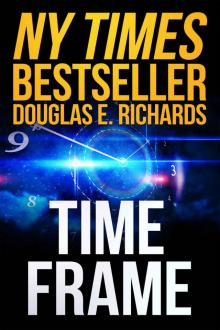 Time Frame
Time Frame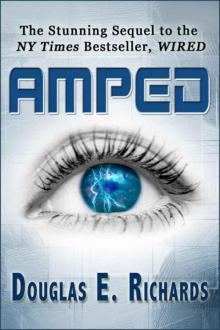 AMPED
AMPED Out of This World
Out of This World AMPED w-2
AMPED w-2